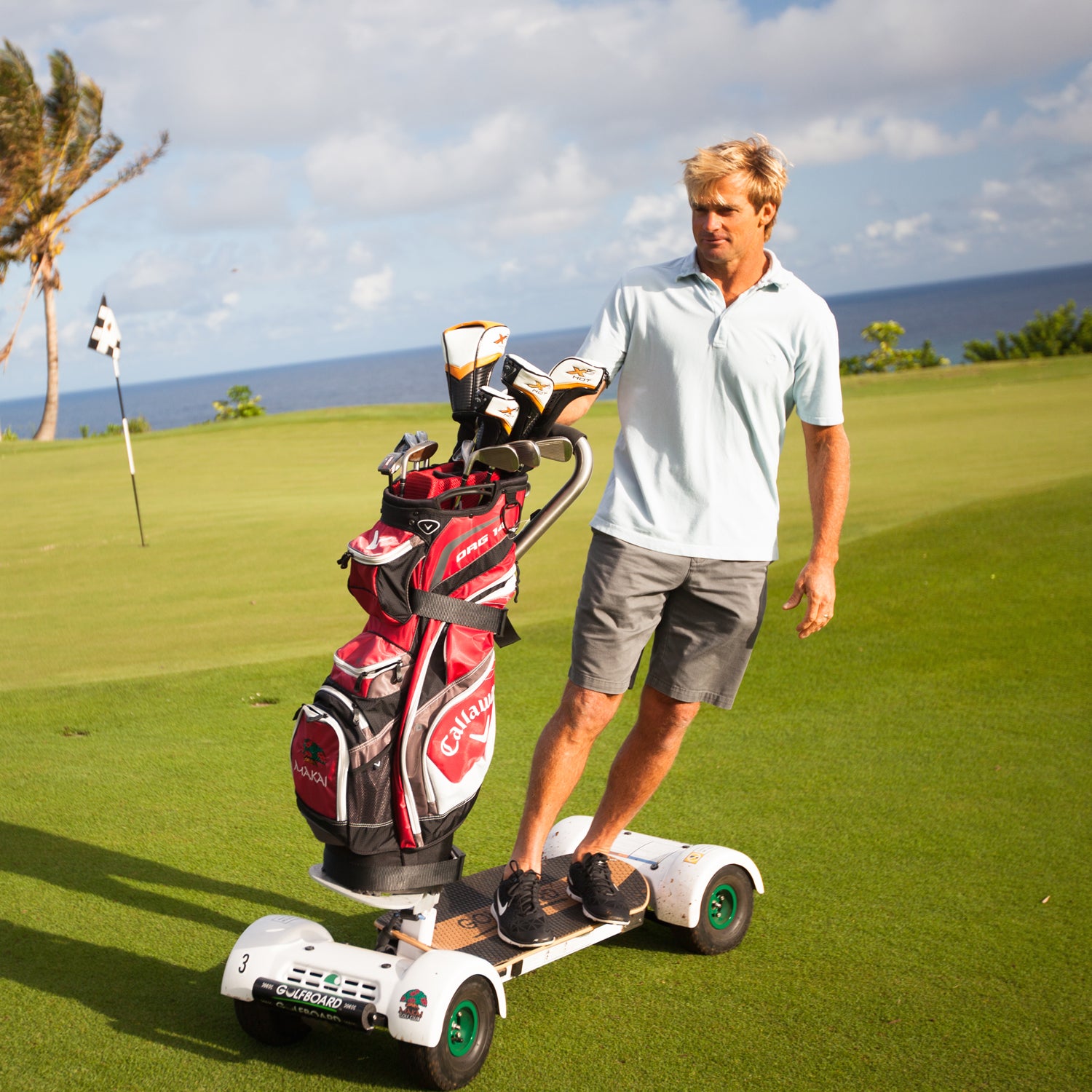Not long ago, I found myself at a tony golf club, about an hour south of Boston, seeking a firsthand feel for a rather anachronistic new product.┬Ā
Since 2014, 52-year-old surfing legend Laird Hamilton has been marketing and selling, with business partners, what they tout as pretty much the biggest innovation in golf since the pimple-faced caddy. Called the , it is a four-wheeled, battery-powered wooden deck with a tall handle that allows a player to ŌĆ£surf the earth,ŌĆØ as promotional materials describe, by swooping up fairways between shots. Since winning Best New Product at the PGA Merchandising Show its debut year, some 160 courses have bought an average of ten boards, at $6,500 a pop.┬Ā
Plans are in place to expand sales to Europe and the Caribbean, and to introduce an on-road or on-bike-path model, with baskets for groceries and nylon windbreakers and such. ŌĆ£ItŌĆÖs been riding a wave of popularity,ŌĆØ president Jeff Dowell told me, unnecessarily.
At Black Rock Country Club on a sunny September day, I chatted a bit with the owner, George McGoldrick, an enthusiastic fan of HamiltonŌĆÖs creation, and zipped off to pretend to play a couple holes without disrupting those who had actual tee times. We mimed chips and sliced drives and, on the Golfboard, glided beside water hazards, mowed through the ruff, and skirted sand traps. After getting the hang of the throttle, a little thumb switch on the handlebar, I confidently cruised along at jogging pace. Thanks to the GolfboardŌĆÖs light weight, I was able to coast right up to the greens without leaving tire tacks in the lawn.┬Ā
It┬ĀwasnŌĆÖt quite like hanging ten in Waikiki, but it did keep me kind of warm, or at least alert, between fake shots.
Riding the undulating fairways wasnŌĆÖt quite like hanging ten in Waikiki, but it did keep me kind of warm, or at least alert, between fake shots. And while I missed the shade of a golf cartŌĆÖs awning, not to mention the cooler full of beer, I came to appreciate that if I was a portly old one-percenter, the Golfboard would be ŌĆ£a hoot,ŌĆØ as one such player told me. ┬Ā
But as I headed back home that day, I couldnŌĆÖt help feeling a bit suspicious.
Let me say outright that this is not because I donŌĆÖt admire Hamilton. In fact, I have to agree with the editors of this magazine, who once confessed to a ŌĆ£man-crush.ŌĆØ┬Ā
In the early 1990s, for example, most people assumed that a 30-foot wave was the tallest any surfer would ever ride, since it was impossible, not to mention terrifying to attempt, to paddle fast enough to catch anything bigger. But soon after Hamilton and two buddies started messing around with an inflatable Zodiac and a tow-rope, they were flinging each other onto some of the most massive waves on the planet. The man invented big-wave surfing.
And in the 1990s and early 2000s, nothing in the surf world was cooler. Sure, some abhorred the proverbial oil in the water. ŌĆ£Every average Joe who can stand up on a board can get towed into a really big wave,ŌĆØ pro Sunny Garcia once groused. But in 2000, Hamilton towed in to a tsunami-like slab of water in Tahiti, rode it like a pony, and those people mostly shut up. ŌĆ£I think itŌĆÖs the single heaviest thing IŌĆÖve ever seen in surfing,ŌĆØ Matt Warshaw, author of , says in the 2004 documentary Riding Giants.┬Ā
Then, for good measure, Hamilton basically invented stand-up paddleboarding. In 2001, he asked some local buddies and surfboard shapers to make him a more seaworthy version of a tandem surfboard, grabbed a paddle, and lo, a new sport was born. Now more than 1 million people go SUPping in a typical year. Granted, many of them are pawing at the water in suburban drainages or stealing actual surfersŌĆÖ waves. But Hamilton, heŌĆÖs a badass.
The Golfboard? That might be another story. For starters, it doesnŌĆÖt strike me as something sprung fresh out of hotshot design-consultancy IDEO. In fact, it bears a striking resemblance to a $6,500 electric skateboard, the likes of which a Shenzen factory owner could duplicate faster than you can say ŌĆ£patent infringement.ŌĆØ┬Ā

Then thereŌĆÖs HamiltonŌĆÖs track record. ItŌĆÖs easy to forget that while he has certainly earned a buckŌĆöenough to split his familyŌĆÖs time between Malibu and HawaiiŌĆöhe has also occasionally indulged his rather peripatetic side. In 2002, the year after creating SUP, for example, he didnŌĆÖt corner the market with his own line, he was still fiddling with another contraption heŌĆÖd invented, which was essentially a wakeboard with a hydrofoil on the bottom and ski boots mounted to the top. Once a kite or jet ski got the rider up to speed, he would rise a couple feet out of the water and hover above unbreaking waves. But as a commercial product, it failed to take off, as Dowell might say, perhaps because no one wanted to wear ski boots in the ocean.
At other times in the last decade, Hamilton has given the impression that heŌĆÖs shooting into the air, hoping for a golden goose to fall out of the sky. He has given speeches to banker types; designed an apparel line, watched it fold, then launched a new collection; published a fitness book; announced the creation of an obstacle race that, two years later, has yet to materialize; has created a ŌĆ£superfoodŌĆØ coffee creamer for jocks and the biohacking subset of Silicon Valley; and has started a fitness camp for those who can afford a private pool, a personal sauna, and an ice bath. He has also dabbled in a bit of modeling, or what may now be called brand-building. In a Davidoff eau de toilette print ad, he runs out of shallow water, with a surfboard under an arm, as if invading the beach at Normandy. Tagline: ŌĆ£The Power of Cool.ŌĆØ In an American Express TV commercial, he says, ŌĆ£My visions are endless.ŌĆØ Indeed.
I emailed Hamilton. Turns out, he eschews email and was busy preparing for the winter big-wave season in Hawaii, but his wife, model and former beach volleyball pro Gabrielle Reece, generously replied.
Hamilton had never been a passionate golfer, she said. But a few years ago, his friend Don Wildman, the rich octogenarian founder of BallyŌĆÖs Total Fitness (now L.A. Fitness), started asking him to play along. Hamilton agreedŌĆöon the condition that he could ride an electric skateboard between holes. ŌĆ£After a while, he and Mr. Wildman realized this would be an incredible way to get around on the course,ŌĆØ Reece said. They got in touch with an inventor and businessman Dowell, and the rest mostly fell in to place.┬Ā
As far as corporate creation stories goes, itŌĆÖs about as compelling as any these days. Which is to say, it ably distracts from the marketers, who were surely chanting, ŌĆ£Laird surfs the earth!ŌĆØ and the eggheads, who were no doubt thrilling at the golf worldŌĆÖs terrific ROIs on key DMAs. But it also does seem, well, authentically Hamilton. He was kind of bored and, with a boy-ish enthusiasm, dreamt up a kooky, novel thing. I wonŌĆÖt be asking to invest, but heck, I wish him all the best.
And IŌĆÖm glad to know that a failure certainly wonŌĆÖt bankrupt him.


